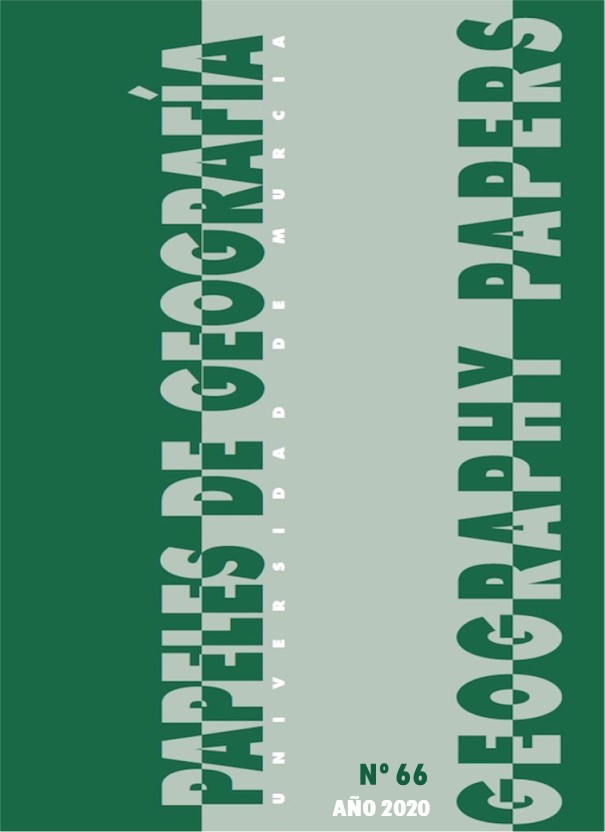Expansión de la soja en México y exclusión productiva de los pequeños agricultores de la península de Yucatán
Resumen
En la península de Yucatán se ha dado un reciente proceso de expansión del cultivo de la soja sobre tierras anteriormente dedicadas a maíz, pastizales y selvas tropicales. Este artículo se inscribe en el debate sobre la “teoría del acceso”, planteándose como objetivos la descripción y análisis de las causas o factores que han motivado dicha expansión, así como de sus impactos en el mercado de tierras e ingreso de los productores. También se reseñan los efectos en el medio ambiente (deforestación) y la economía de los apicultores. La investigación reveló cómo una elite de productores y agro–empresas han tenido la habilidad de ganar, controlar y mantener el recurso tierra, a través de diversos mecanismos de acceso, mientras que los pequeños productores (propietarios legales) se han convertido en rentistas de sus tierras, ubicándose en una situación de “exclusión productiva”.
Palabras clave: soja; exclusión productiva; teoría del acceso; Península de Yucatán; México.
Descargas
-
Resumen1246
-
PDF1350
Citas
BERG, B. (2009): Qualitative Research Methods for the Social Sciences. Toronto: Allyn and Bacon.
BOHN, T., CUHRA, M., TRAAVIK, T., SANDEN, M., FAGAN., J. y PRIMICERIO, R. (2014): “Compositional differences in soybeans on the market: Glyphosate accumulates in Roundup Ready GM soybeans”, Food Quemistry 153: 207–215.
CÁCERES, D. (2014): “Accumulation by dispossesion and socio–environmental conflicts caused by the expansion of agribusiness in Argentina”, Journal of Agrarian Change 15 (1): 116–147.
CARRERA, H. (2017): “Empresarios y menonitas continúan siembra de soja transgénica”, La Jornada Maya, 28 de agosto.
CASTILLO, C. (2017): “Menonitas devastan la selva Bacalarense”, Novedades de Quintana Roo, 18 de julio.
CCMSS (CONSEJO CIVIL MEXICANO PARA LA SILVICULTURA SOSTENIBLE) (2019): Superficie sembrada de soja en la península de Yucatán. Disponible en: http://132.248.14.102/layers/CapaBase:cultivosoja_peninsula [Consulta: 24/09/2019].
DUPUY, J., DURÁN, R., GARCÍA, G., ARELLANO, J., ACOSTA, E., MÉNDEZ, M. y ANDRADE, M. (2015): “Conservation and Use”. En Islebe, G., Calmé, S., León, J. y Schmook, B. (Eds.), Biodiversity and Conservation of the Yucatán Peninsula. Switzerland: Springer International Publishing.
ECHÁNOVE, F. (2016): “La expansión del cultivo de la soja en Campeche, México: Problemática y perspectivas”, Anales de Geografía 36 (1): 49–69.
ECHÁNOVE, F. (2017): “Subsidies for Price Risk in Grains: The Case of Maize in Mexico”, Journal of Iberian and Latin American Research 23 (1): 46–61.
ECHÁNOVE, F. (2018): “Reconversión productiva en Yucatán, México: de maíz y pastizales a soja”, Papeles de Geografía 64: 181–197.
ELLIS, E., ROMERO, J., URIEL, I., PORTER, L. y ELLIS, P. (2017): “Private property and Mennonites are major drivers of forest cover loss in central Yucatan Peninsula, Mexico”, Land Use Policy 69: 474–484.
ENTREPRENEUR (2017): “Qué es Agrotech y cómo lo puede aprovechar”. Disponible en: https://www.entrepreneur.com/article/300517 [Consulta: 23/08/2017].
ESTOS DÍAS (2019): “La comunidad menonita extiende su frontera agrícola echando la selva abajo”, 28 de mayo.
EZQUERRO, A. (2016): “Poisoned, Dispossessed and Excluded: A Critique of the Neoliberal Soy Regime in Paraguay”, Journal of Agrarian Change 16 (4): 684–692.
FAO (ORGANIZACIÓN DE LAS NACIONES UNIDAS PARA LA ALIMENTACIÓN Y LA AGRICULTURA) (2019): International Prices. Disponible en: https://fpma.apps.fao.org/giews/food-prices/tool/public/#/dataset/international [Consulta: 23/08/2019].
FOLEY, J. (2011): “Can we feed the world and sustain the planet?”, Scientific American, Noviembre.
GEOCOMUNES (2019): Superficie sembrada con soja en la Península de Yucatán. Disponible en: http://132.248.14.102/layers/CapaBase:cultivosoja_peninsula [Consulta: 12/09/2019].
GFW (GLOBAL FOREST WATCH) (2019): Disponible en: https://www.globalforestwatch.org/map/country/MEX/ [Consulta: 2/09/2019].
GÓMEZ, I. (2016): “A honey-sealed alliance: mayan beekeepers in the Yucatan peninsula versus transgenic soybeans in Mexico’s last tropical forest”, Journal of Agrarian Change 16 (4): 728–736.
GOOGLE EARTH PRO (2019): Disponible en: https://www.google.com/earth/ [Consulta: 3/07/2019].
GRAIN (2014): “2.4–D soy: waging war on peasants”. Disponible en: http://www.grain.org/article/entries/ [Consulta: 7/08/2018].
HALL, D., HIRSCH., P. y LI, T. (2011): Powers of exclusion. Singapore: National University of Singapore Press.
HANSEN, A. (2018): “Meat consumption and capitalist development: the meatification of food provision and practice in Vietnam”, Geoforum 93: 57–68.
HERNÁNDEZ, S. (2017): “Señalan menonitas a grupos “liberales” en Quintana Roo”, El Universal, 11 de septiembre.
HERRERO, M., THORNTON, P., GERBER, P. y REID, R. (2009): “Livestock, livelihoods and the environment: understanding the trade-offs”, Current Opinion in Environmental Sustainability 1: 111–120.
HERRERO, M., WIRSENIUS, S., HENDERSON, B., RIGOLOT, C., THORNTON, P., HAVLÍK, P. y GERBER, P. (2015): “Livestock and the environment: What have we learned in the past decade?”, Annual Review of Environment and Resources 40: 177–202.
KELLY, J. (2019): “Village–scale reserves in the forest frontier regions of Chenes and Calakmul, Mexico”, Journal of Land Use Science: 1–17.
LEGUIZAMÓN, A. (2016): “Environmental Injustice in Argentina: Struggles against Genetically Modified Soy”, Journal of Agrarian Change 16 (4): 684–692.
MACHOVINA, B., FEELEY, K. y RIPPLE, W. (2015): “Biodiversity conservation: The key is reducing meat consumption”, Science of the Total Environment 536: 419–431.
MASON, R. (2013): “Glyphosate: destructor of human health and biodiversity”. Disponible en: http://www.uccs.mx/ [Consulta: 30/07/2018].
MCKAY, B. y COLQUE, G. (2016): “Bolivia´s soy complex: the development of “productive exclusión”, The Journal of Peasant Studies 43 (2): 583–610.
MILGROOM, J. y RIBOT, J. (2020): “Children of Another Land: Social Disarticulation, Access to Natural Resources and the Reconfiguration of Authority in Post Resettlement”, Society and Natural Resources 33 (2): 184-204.
MUÑOZ, G. (2018): “Transgénicos: no es no”, La Jornada, 12 de mayo.
NADERIFAR, M., GOLI, H. y GHALJAEI, F. (2017): “Snowball Sampling: A Purposeful Method of Sampling in Qualitative Research”, Strides in Development of Medical Education 14 (3): 1–6.
PELUSO, N. y RIBOT, J. (2020): “Postscript: A Theory of Access Revisited”, Society and Natural Resources 33 (2): 300-306.
PELUSO, N. y LUND, C. (2011): “New frontiers of land control: Introduction”, The Journal of Peasant Studies 38 (4): 667–681.
PIEDRA, M. (2016): “El cultivo de soja transgénica en Quintana Roo: estudio de caso Ejido Salamanca, Bacalar”, Tesis de Maestría, El Colegio de la Frontera Sur.
PORTER, L., SÁNCHEZ, M. y ELLIS, E. (2008): “La conformación del paisaje y el aprovechamiento de los recursos naturales por las comunidades mayas de La Montaña, Hopelchén, Campeche”, Investigaciones Geográficas 66: 65–80.
PROFEPA (PROCURADURÍA FEDERAL DE PROTECCIÓN AL AMBIENTE) (2017): “Afectaciones ambientales de comunidades menonitas en Coahuila, Campeche y Quintana Roo”, Disponible en: https://www.gob.mx/profepa/prensa/ [Consulta: 22/09/2019].
REBORATTI, C. (2010): “Un mar de soja: la nueva agricultura en Argentina y sus consecuencias”, Revista de Geografía Norte Grande 45: 63–76.
RENDÓN, J. y DZUL, R. (2017): “Glyphosate Residues in Groundwater, Drinking Water and Urine of Subsistence Farmers from Intensive Agriculture Localities: A Survey in Hopelchén, Campeche, Mexico”, International Journal of Environmental Research and Public Health 14 (6): 2–13.
RIBOT, J. (1998): “Theorizing Access: Forest Profits along Senegal´s Charcoal Commodity Chain”, Development and Change 29: 307–341.
RIBOT, J. y PELUSO, N. (2009): “A Theory of Access”, Rural Sociology 68 (2): 158-181.
SADER (SECRETARÍA DE AGRICULTURA Y DESARROLLO RURAL) (2019): “Incentivo para Administración de Riesgos de Precios (Coberturas)”. Disponible en: https://www.gob.mx/agricultura [Consulta: 19/03/2019].
SIAP (SERVICIO DE INFORMACIÓN AGROALIMENTARIA Y PESQUERA) (2019): Producción Agrícola Anual. Disponible en: https://www.gob.mx/siap/ [Consulta: 19/08/2019].
SUÁREZ, P. (2005): “Migración y salud en una comunidad rural del estado de Campeche”, Tesis de Maestría, CINVESTAV Mérida.
TORRES, G., FERNÁNDEZ, J. y GÓMEZ, C. (2018): “La Jurisdicción Agraria y los Derechos Humanos de los Pueblos Indígenas y Campesinos en México”. México: Fundación para el Debido Proceso.
TORRES, G. (2018): “Nosotros decimos Ma’: la lucha contra la soja transgénica y la rearticulación de la identidad maya en la península de Yucatán”, The Journal of Latin American and Caribbean Anthropology 23 (2): 262–280.
UH, J. (2013): “Organización social de los menonitas de Salamanca, Quintana Roo”, Tesis de Licenciatura, Universidad de Quintana Roo.
USDA (DEPARTAMENTO DE AGRICULTURA DE ESTADOS UNIDOS) (2019): “Oilseeds: World Markets and Trade”. Disponible en: https://apps.fas.usda.gov/psdonline/circulars/oilseeds.pdf [Consulta: 7/09/2019].
VILLANUEVA, R., ECHAZARRETA, C., GONZÁLEZ, D., ROUBIK, D. y MOGUEL, Y. (2014): “Transgenic soybean pollen (Glycine max L.) in honey from the Yucatan península, Mexico”, Scientific Reports 4: 1–4.
WEIS, T. (2013): The ecological hoolprint: The global burden of industrial livestock. New York y London: Zed Books.
WHO (WORLD HEALTH ORGANIZATION) (2015): “Evaluation of five organophosphate insecticides and herbicides”. IARC Monographs 12.
- 29-01-2021 (2)
- 29-01-2021 (1)
Derechos de autor 2021 Papeles de Geografía

Esta obra está bajo una licencia internacional Creative Commons Atribución-NoComercial 4.0.
Las obras que se publican en esta revista están sujetas a los siguientes términos:
1. El Servicio de Publicaciones de la Universidad de Murcia (la editorial) conserva los derechos patrimoniales (copyright) de las obras publicadas, y favorece y permite la reutilización de las mismas bajo la licencia de uso indicada en el punto 2.
2. Las obras se publican en la edición electrónica de la revista bajo una licencia Creative Commons Reconocimiento-NoComercial 4.0 (texto legal). Se pueden copiar, usar, difundir, transmitir y exponer públicamente, siempre que: i) se cite la autoría y la fuente original de su publicación (revista, editorial y URL de la obra); ii) no se usen para fines comerciales; iii) se mencione la existencia y especificaciones de esta licencia de uso.
3. Condiciones de auto-archivo. Se permite y se anima a los autores a difundir electrónicamente las versiones pre-print (versión antes de ser evaluada) y/o post-print (versión evaluada y aceptada para su publicación) de sus obras antes de su publicación, ya que favorece su circulación y difusión más temprana y con ello un posible aumento en su citación y alcance entre la comunidad académica. Color RoMEO: verde.








